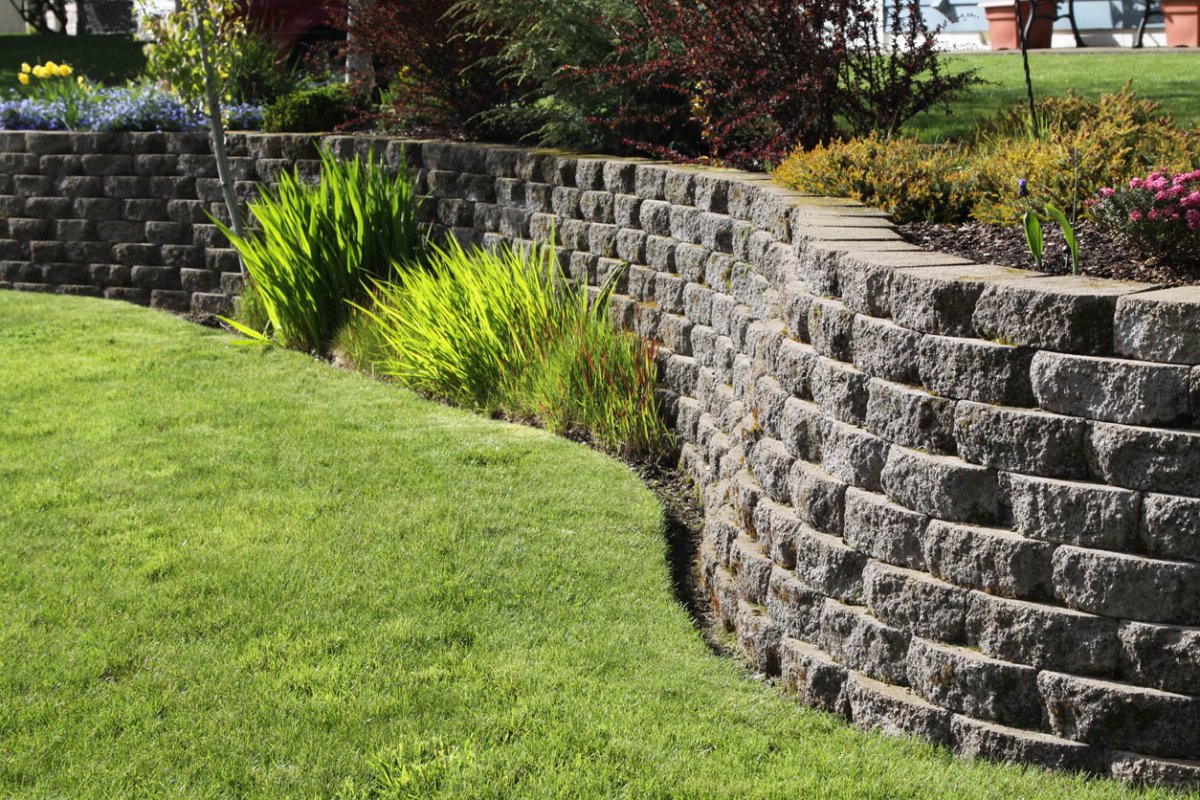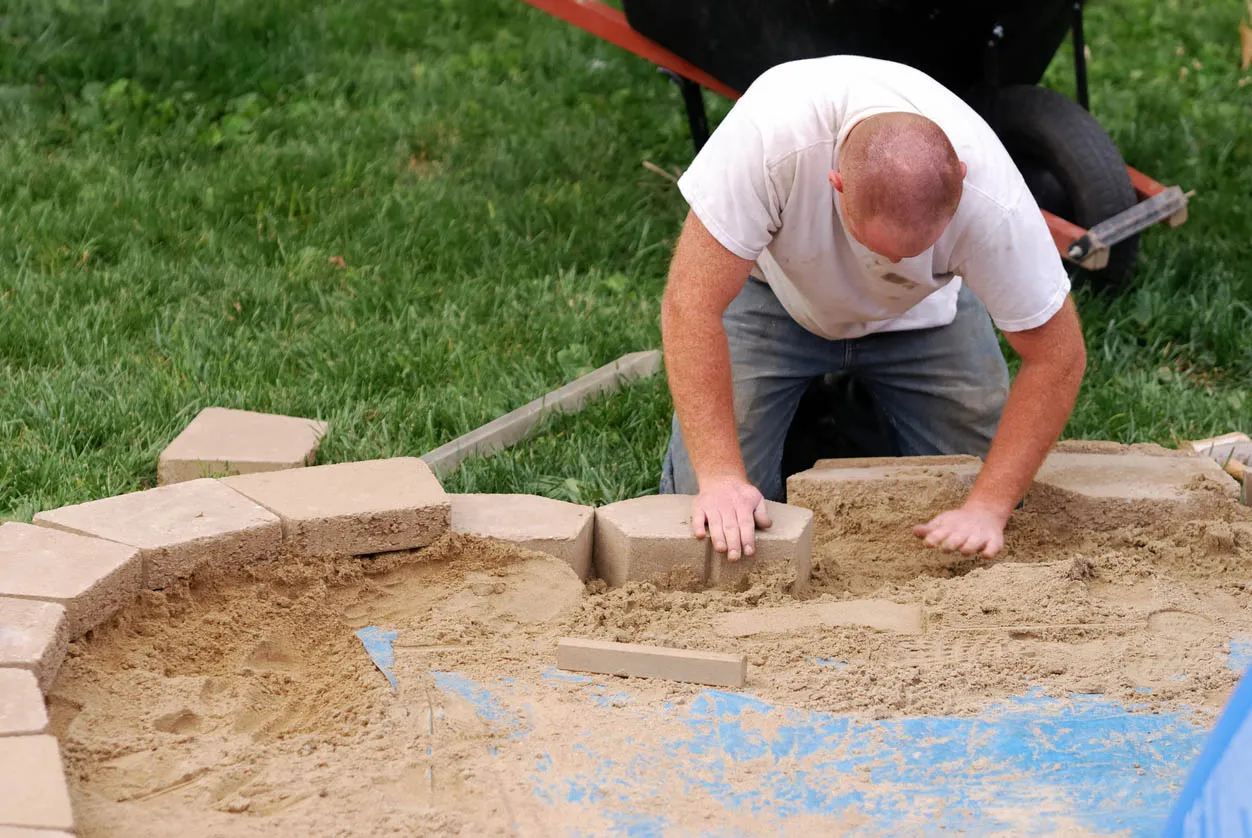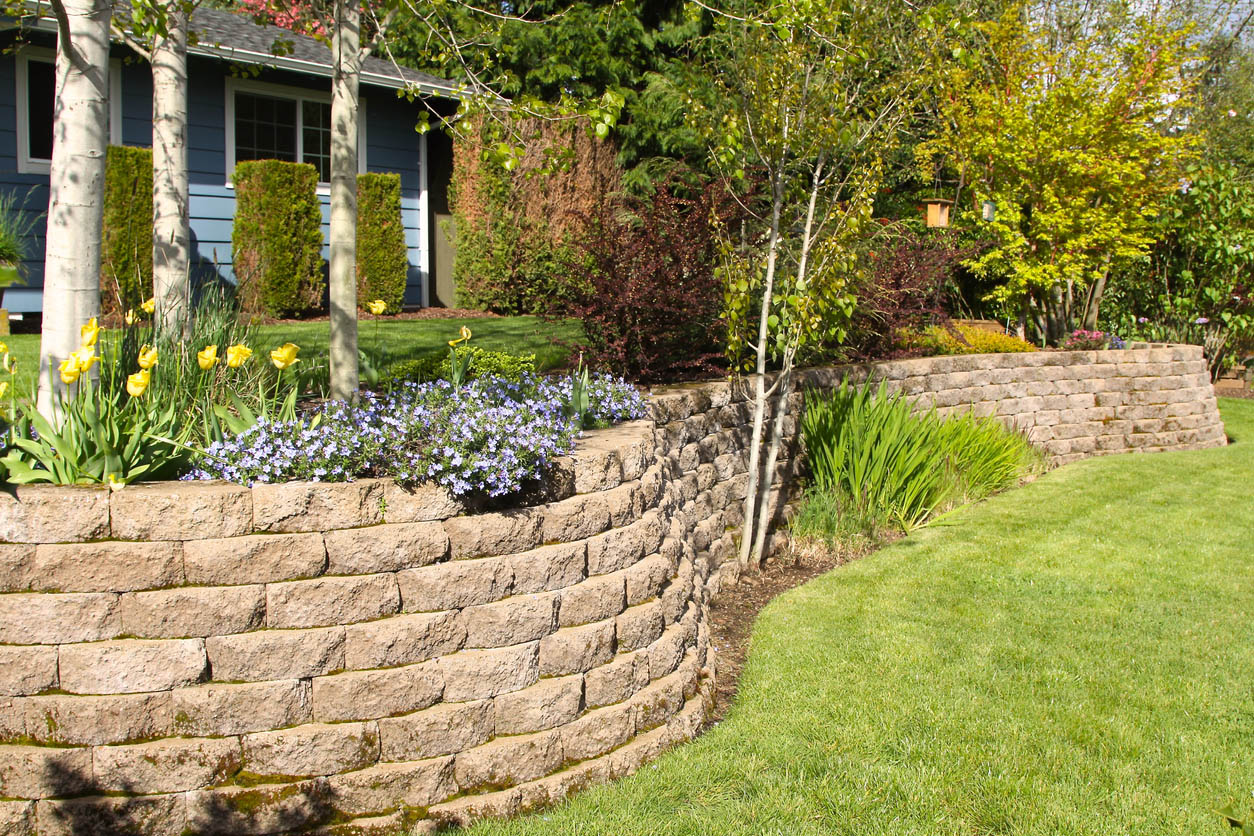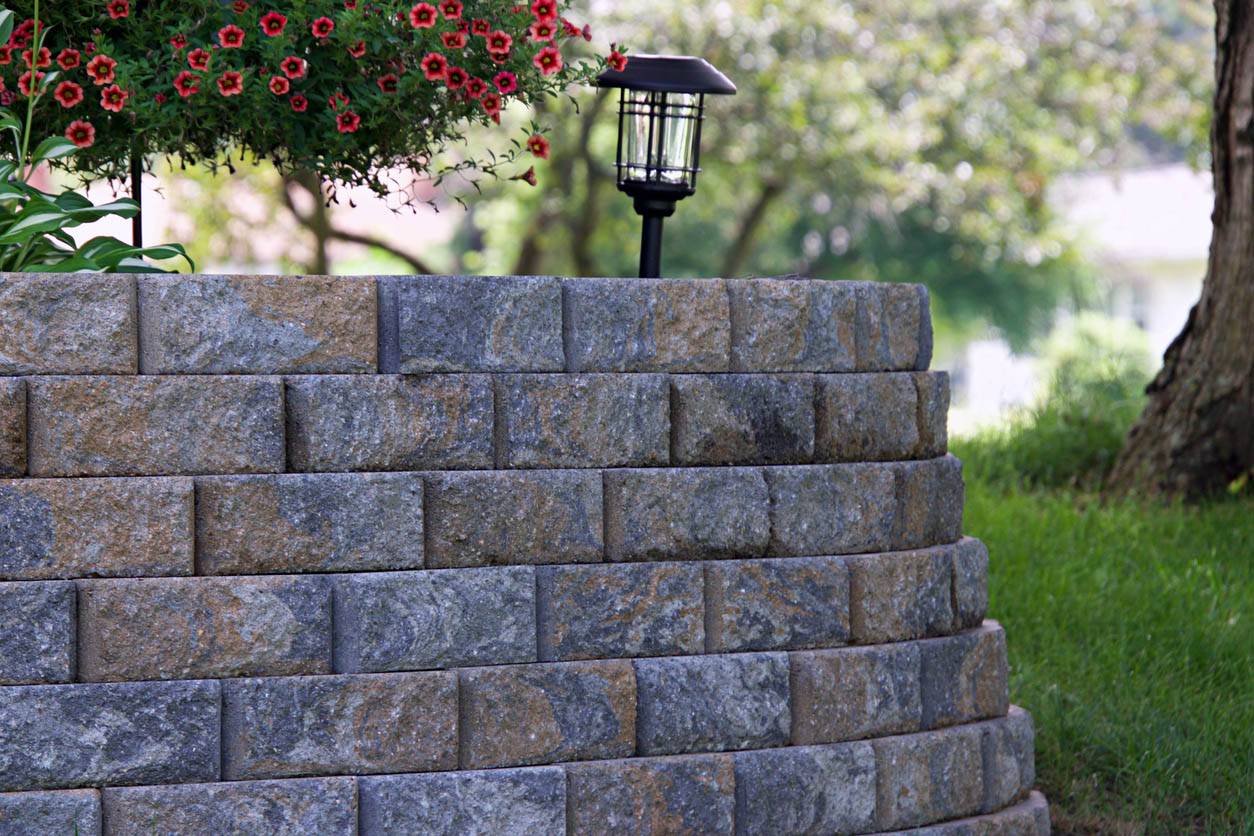

We may earn revenue from the products available on this page and participate in affiliate programs. Learn More ›
Highlights
- It typically costs between $3,199 and $9,196 to build a retaining wall, while the national average cost is $6,060.
- The precise cost will depend on factors like the materials used, the location and size of the wall, the cost of labor and permits, and the type of soil.
- Retaining walls can prevent erosion, act as a water barrier, and stabilize sloped areas without regrading.
- Building a small retaining wall may be doable for an experienced DIYer, but larger and more complex designs are best left to the pros.
What is a retaining wall? Retaining walls can prevent soil erosion, hold a foundation in place, beautify a yard, divert water, and facilitate drainage. They can be made of various materials and built to any size, length, and height. But what does a retaining wall cost? The cost to build a retaining wall depends on several factors, but according to Angi and HomeAdvisor, the price ranges from $3,199 to $9,196, with the national average at $6,060.
The final price depends on the retaining wall materials, the size of the wall, engineering, location, reinforcement, and decorative finishes. Since every retaining wall project is unique depending on the size and materials, labor costs can also fluctuate. Depending on materials, labor can run between $50 and $75 per hour or $10 to $50 per square foot. Interlocking retaining wall blocks results in faster construction than using other materials, like hand-stacked stone.
Before searching online for “inexpensive retaining wall ideas” or “how to build a retaining wall,” keep reading for important information regarding factors in calculating retaining wall cost, types of material, and essential questions about retaining wall installation.
Factors in Calculating Retaining Wall Cost
Several factors can affect retaining wall costs. Prices can be different from the national average due to the material, location, size, height, accessibility of the area, labor costs, permit fees, soil, site preparation, material delivery fees, waterproofing, geographic location, and the time of year.
Materials
The type of material will impact labor prices and the project’s overall cost. The type of material used to build a retaining wall depends on personal preference, although the required size and height of the wall can also dictate the material. Some homeowners prefer to mix and match different materials to create visual interest while reinforcing the function of the structure. Materials include concrete, gabion and stone, brick, wood or timber, railroad tie, steel, I-beam, and rammed earth. Each material has its advantages, benefits, and pricing per linear foot.
Wall Location
The location and the amount of reinforcement are significant factors that impact retaining wall costs. Since no two retaining walls are the same, it’s important to recognize the function of the wall and carefully understand how much force it needs to withstand. Here are some common locations for retaining walls and their price per linear foot.
- Driveway: $50 to $150 per linear foot
- Landscape: $30 to $150 per linear foot
- Shoreline: $125 to $200 per linear foot
- Swimming pool: $20 to $100 per linear foot
- Backyard: $30 to $150 per linear foot
- Front yard: $30 to $200 per linear foot
- Slope: $40 to $200 per linear foot
Size and Height
When calculating retaining wall costs, it’s essential to consider the wall’s length, height, and width. Material and labor costs are dependent on the overall size. Keep in mind that the larger the retaining wall, the stronger a foundation it will need.
Accessibility
Easier access to the location where the retaining wall will be built will allow large earthmoving machines to do most of the work. Expect to pay more for manual labor in difficult-to-access areas.
Labor and Permits
Labor costs run from $50 to $75 per hour or $10 to $50 per square foot. If the location where the retaining wall is being built is difficult to access, the area will require scaffolding and reinforcement. Existing gates and fences may need to be removed as well. In a situation like this, prepare to pay the higher end of the labor estimate. Walls over 4 feet tall and walls that need to hold back a significant amount of weight will need to be designed by a structural engineer. This process will cost more since it will take more time and effort to design and build the wall.
In many areas, a permit is required if the retaining wall is over 3 or 4 feet tall. Homeowners should check their local regulations regarding retaining walls before starting the project. Permits usually cost between $50 to $450.
Type of Drainage
Since the function of a retaining wall is to stop erosion and facilitate drainage, the retaining wall’s design is important. Drainage can be designed into the wall by using drainage pipes, gravel and weep holes, or a criblock design. If there is a retaining wall on the property but it doesn’t drain, it may need to be rebuilt. Sometimes a contractor can dig out the area behind the wall and place gravel at the base to ensure drainage, but this is not always possible. If it’s not, a contractor may need to take out the wall and rebuild it. Excavating to remedy drainage issues can cost $60 to $70 per linear foot. The cost to demolish the existing wall ranges from $20 to $30 per square foot, not including adding drainage or building the new wall.

Type of Soil
The soil type plays a significant factor in deciding the type of retaining wall that will work the best for the area. Some retaining walls work better in certain types of soil than others. The soil may need to be compacted or modified to drain and withstand the wall’s weight. Sandy soils are best for drainage, and clay soil will not be able to support a wall’s weight. Getting a geotechnical report on the soil will show the chemical properties, groundwater conditions, and any issues with the soil.
Site Preparation
Before a retaining wall can be built, the site needs to be excavated and leveled. This involves clearing the land and compacting the soil so the wall will be level. The cost of clearing land can run between $500 and $1,000, depending on the location, condition of the land, and size of the construction site. Clearing difficult terrain can run from $1,500 to $3,000 per acre, tree removal can cost from $300 to $700 per tree, and land grading ranges from $0.40 to $2 per square foot.
A layer of gravel or sand can be used to ensure proper drainage, or a contractor can install drainage pipes or weep holes every 6 to 8 feet. Other drainage options include installing filter fabric or a footing drain. Keep in mind that some of these options work better in certain conditions, and not every option will be used when installing a retaining wall.
Material Delivery
Some contractors may charge an extra delivery fee, depending on the material. The common price is usually between $30 and $100 per truckload for brick, stone, or concrete retaining wall blocks.
Waterproofing
To ensure a retaining wall lasts decades, it needs to be waterproofed. This typically costs between $2 and $10 per square foot. The price is usually included with the overall cost of the project, but it’s always good to ask the contractor about waterproofing. If the retaining wall isn’t waterproofed, water can seep into the wall and damage its structural integrity.
Geographic Location
Certain types of retaining walls work better in some geographic locations than others. Steel retaining walls are not used in coastal areas since the material can rust. Railroad ties are banned for use as retaining wall material in some areas. Permit, construction, and labor fees are all different in each state and city. It’s important to get quotes from contractors in your area for accurate pricing.
Additional Costs and Considerations
When budgeting for retaining wall costs, it’s beneficial to know about any additional costs and considerations. These can include additional services, reinforcements, additional dirt fill, and customizations.
Time of Year
While retaining walls can be installed at any time of the year, it may cost more for construction and labor costs to dig below the frost line when the ground is frozen.
Additional Services
Longer retaining walls and those over 4 feet high will typically need a structural engineer to design them. Hiring a structural engineer, designer, or professional landscape architect will add to the project’s overall price.
Reinforcements
A concrete retaining wall typically needs reinforcement. Lateral support is usually inserted with rebar, or reinforcing bars. Rebar can be inserted horizontally and vertically, depending on the needed reinforcement. Additional reinforcement is commonly used in retaining walls that are taller than 4 feet. The cost to install rebar runs from $0.80 to $1.60 per square foot. Taller and longer walls need deep footings with different fill materials for additional reinforcement. Structural engineers will design the wall to prevent it from collapsing.
Additional Dirt Fill
If additional fill dirt is needed, it can cost between $150 and $600 per truckload, or $15 to $50 per yard.
Customizations
Retaining walls can be easily customized to complement the look of the surroundings or enhance the area for entertaining. Retaining wall add-ons include:
- Brick facade or veneer: $5 to $30 per square foot
- Concrete footing: $30 to $100 per linear foot
- Stone veneer: $35 to $50 per square foot
- Painted mural: $800 to $1,900
- Fencing: $1,700 to $4,000
- Patio: $1,800 to $5,200
- Outdoor lighting: $2,000 to $6,000
- Stamped concrete: $2,700 to $6,500

Retaining Wall Material Types
The retaining wall material can be the most expensive part of the project. It’s important to know the pricing of stone, wood, steel, concrete, and other materials to keep your budget on track.
Concrete
Concrete retaining walls can cost between $10 and $100 per square face foot. The main types of concrete walls are cement, shotcrete, poured concrete, and precast concrete. Cement is not as hard as concrete, but it’s a budget-friendly option. Shotcrete may be one of the most affordable concrete retaining walls, and it’s a quicker installation than cast-in-place concrete. Poured concrete and precast concrete are typically the most expensive options. Concrete blocks are hollow and will need to be reinforced with steel.
Gabion and Stone
Gabion and stone retaining walls can range from $5 to $100 per square foot. Gabion walls are made from wire cages that are filled with rocks. Since they don’t need concrete footing, they’re easy to install and can stabilize the soil while handling landscape shifts.
Stacked stones can be used for taller, tiered, and decorative walls. Dry-stacked stone retaining walls use gravity to keep the wall together. These are typically cheaper to install than wet-laid stone walls that rely on mortar. Natural stone walls cost between $25 and $75 per square foot. Limestone is a more expensive option and can cost between $50 and $100 per square foot.
Brick
The cost of installing a brick retaining wall is between $10 and $45 per square foot. This material acts as a veneer on the wall. One layer of brick is affixed to a retaining wall made of blocks or poured concrete. Brick can be used for a tiered or taller wall to create a classic look.
Wood or Timber
Wood is a popular and budget-friendly material and costs between $15 and $30 per square foot. Timber retaining walls are typically used in gardens or to reshape sloped areas. Wood retaining wall drainage must be installed correctly since the material is prone to water damage. Proper waterproofing and drainage will allow a wooden retaining wall to last for decades.
Railroad Tie
Commonly seen in older homes, railroad tie retaining walls usually cost between $25 and $30 per square foot. Today, this material is less common because railroad ties can be coated in toxic creosote. Be sure to double-check if railroad ties are an approved material for retaining walls in your area.
Steel
Steel retaining walls run $40 to $60 per square foot. Customers in coastal areas typically opt for galvanized steel since it lasts longer. Corten steel is the strongest steel option that withstands rust, but the price increases to $75 to $125 per square foot for this material. Homeowners can save 25 to 50 percent of the cost by using a concrete or wood wall that’s faced with a sheet of Corten steel.
I-Beam
I-beam retaining walls range from $40 to $90 per square foot. As one of the most expensive options, I-beam walls, also called soldier pile, are made with vertical I-beams placed into holes and secured with concrete. Precast concrete panels or wooden slats are positioned between the beams to create the wall. These types of walls are commonly used to prevent soil erosion or as property line markers.
Rammed Earth
Rammed earth retaining walls cost between $20 and $30 per square foot. These walls are created by mixing dirt with a binder to create a sound structure. The most common binder is concrete, which enhances the wall’s strength. Since fewer materials are required for this, it’s a more environmentally friendly option.
Do I need a retaining wall?
Retaining walls are used for many reasons, including soil erosion prevention, landscape maintenance, and visual interest. If your property has issues with erosion or water drainage, a retaining wall may be needed. Here are some other reasons a property may need a retaining wall.
Erosion Prevention
Retaining walls are useful for preventing soil erosion and keeping sloping land in good condition. For yards with septic tanks, retaining walls are used to build up the area and create a visual barrier to the other parts of the property.
Water Barrier
If a property is having issues with water drainage or it’s near a body of water that needs to be protected, a retaining wall can help. Retaining walls near a shoreline prevent erosion and hold back the water. A wall is also helpful if stormwater pools around a structure’s foundation.
Slope Stabilization
Sloping land typically needs a retaining wall to prevent soil erosion. Building a retaining wall in a sloping area will require regrading the land. It’s usually more difficult to construct a wall on a slope since it’s an unstable area.
Existing Retaining Wall Issues
If an existing retaining wall on the property needs replacement, the cost will be the same as building a new one, plus the added charges to demolish the old one. The area will also need to be prepped and regraded. A retaining wall fails due to its age, improper construction, or inadequate reinforcement.
Benefits of Installing a Retaining Wall
Building a retaining wall has many advantages, such as preventing landslides, stabilizing hilly landscapes, providing flood control, adding functional space to a yard, and increasing the overall value of a home.
Yard Expansion
While hilly and sloping land may be what draws a homeowner to a property, it’s impractical to use on a daily basis. By installing a retaining wall or series of walls, the landscape can be transformed into a flat area that can be used as a garden or patio.
Curb Appeal
Depending on the material used for the retaining wall, it can beautifully contrast with the surrounding natural landscape. Walls can double as seating areas and function as an additional structural feature outside the home. Building a retaining wall can add up to 15 percent to the value of a home and a 100- to 200-percent return on investment.
DIY vs. Hiring a Professional
Shorter, smaller retaining walls made from dry stacked stone or concrete blocks can make a good DIY project. But since taller walls need reinforcement, it’s important to not build a retaining wall taller than 3 or 4 feet on your own. And while shorter walls are easier to build, it can be difficult to ensure they’re structurally sound without the proper knowledge and experience.
If a wall is built incorrectly, the wall can collapse and damage the surrounding landscape. If a retaining wall needs to be rebuilt, the additional costs to demolish and haul away the material will quickly add on to the price of rebuilding. Keep in mind that some locations require a structural engineer to design a retaining wall and a professional to build it. For these reasons, it’s generally a good idea to hire a professional to build a retaining wall.
How to Save Money
Budgeting for retaining wall costs can be challenging, and the additional fees associated with the job can quickly add up. Homeowners may be tempted to search for inexpensive, cheap retaining wall ideas, but there are other ways to save without compromising what you want.
- Get multiple quotes. Get at least three quotes from reputable contractors in your area.
- Use recycled materials. Some contractors offer recycled concrete from other locations. If you are demolishing an existing retaining wall on your property, see if any of that material can be reused.
- Combine projects. If you’re planning multiple backyard improvements, schedule the other projects with the same company to see if you qualify for discounts.
- Stick to your budget. While opting for the most expensive materials is tempting, search for affordable materials that complement both function and form.
- Negotiate. Some companies have some wiggle room with their installation costs to help meet your budget.

Questions to Ask a Pro
Asking the right questions about retaining wall costs can minimize miscommunication and save money. Here are some questions to ask a retaining wall installation professional.
- Are you licensed and insured?
- Will you provide references?
- Do you have examples of your work?
- Do we need a building permit?
- How can you help with water drainage issues?
- Will you use landscape fabric?
- What is the best material for this location?
- How long will it take to install the retaining wall?
- Who will build the wall?
- Who should I contact if there are problems?
- Do you guarantee your work?
FAQs
Staying within your budget for retaining wall costs can be daunting. Here are some frequently asked questions about retaining wall costs to help guide you in your decisions.
Dry-stacking masonry blocks no taller than 3 feet is the easiest way to build a retaining wall for the average DIYer. Those with masonry experience should have no problem using mortar and building a wall with other materials. Those with no DIY experience should contact a professional to design and install a retaining wall.
Absolutely. A retaining wall can add up to 15 percent to a home’s value and an average of 100- to 200-percent return on investment.
Depending on the wall material, the quality of the soil, the groundwater, and proper maintenance, a retaining wall can last between 25 to 100 years.
Angi, HomeAdvisor, Fixr, HomeGuide
